Move On Up: Possessions in Unpacking
By gamer_152 0 Comments
Note: The following article contains major spoilers for Unpacking.

We don't realise the absurd volume of possessions we own until we move, when we have to pull every shirt from its hanger and kitchen utensil from its drawer and ship them off somewhere new. On the other side of that move, we're faced with a daunting forest of boxes, one that seems so much larger than our storage space. But then something miraculous happens. Your new home reveals itself to be a non-euclidean space and cupboards and cabinets that must be bigger on the inside than the outside swallow your belongings up. For however much stuff you have, there are the containers to hold it.
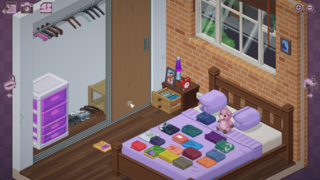
Witch Beam's Unpacking is a blend of spatial reasoning trials, opportunities for self-expression, and storytelling, and is a reel of every time its protagonist had to stir together a new home and old possessions. I've known more than a few people who've compared fitting all their detergent into a laundry room or shoes into a closet to playing Tetris. Unpacking dispenses with the simile. It cuts right to describing moving in as a matter of maximising your use of space. It simultaneously asks you to find sensible placements for your items. Yet, because the appropriate home for each teaspoon and figurine depends on the positions of those around it, you can discover that your initial placement for an object is less than ideal and that you need to relocate it. Decorating is redecorating. This is especially true if you're pulling belongings out from their boxes one at a time. You can plan more effectively if you lay everything out on the floor before you start putting mats on tables and paintings on walls. Both setting out the items before you begin and winging your unpacking require no shortage of work, but because you can choose between them, the game gives you a choice about the kind of work you undertake.
You also have a reason to be thorough in your composition of the environment. Most games give you a motive to go above and beyond the primary goal: a higher score, extra stars, anything that says you did more than the compulsory. In these houses and apartments, your primary goal is to put everything away, but your bonus goal is to make the kind of home you'd want to live in. It's not an objective every gamer is going to be tempted by, but it is fetching to anyone already playing an interior design simulator. While visual customisation in games is traditionally seen as disconnected from challenge and play, in Unpacking, gussying up your space is the puzzle.
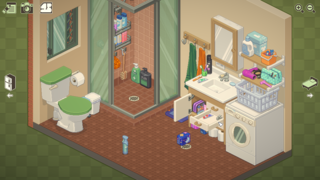
The game has explicit rules prescribing what goes where: you have to place the toothbrush in the bathroom, you can't leave your coffee cups in the middle of the floor, etc. But many of the mandates we follow are the implicit rules of home design rather than any edict enforced by the software. Decorating often consists of making stacks and islands of items with enough space between them to avoid our home feeling claustrophobic. We often aim to form those islands into pleasing shapes, but we're also trying to make their constituents match. That could be a match of shape, colour, material, or function. E.g. They're all warm-coloured items, or they're all cleaning chemicals. We also want to keep the average time to reach any one object low.
In Unpacking, we run up against these realistic hitches in which we can't clump together an island or satisfy multiple grouping criteria at the same time. That's always due to some combination of odd items out and space being at a premium. For example, we might have one sock that does not match the others or a plate that's not the colour of the rest of a set. We could have more toiletries than space on the shower shelf or more cutlery than would fill one drawer but not enough to fill two. These leftover objects force us into imperfect decorating, and it's in those imperfections that player actions are most likely to diverge. Give two homeowners a bookcase with twelve spaces and twelve books, and they'll both put the twelve books in the case. But give them the same empty area and thirteen books, and chances are they'll each find a unique spot for that orphan book. The more individual a decorating choice, the more sharply it represents us.
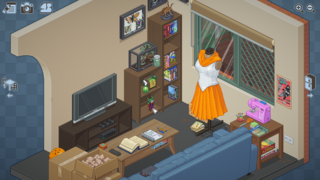
As a tree can spread its roots and make itself part of the woods, filling out our homes allows us to stretch our tendrils over a whole building. If fashion enables us to show our inside on the outside by wearing a coat or a hat, interior design allows us to state who we are by wearing a house. When you live with other people, it's also a means to retain close proximity with each other, even when you're not in the same room. Although, that can be a double-edged sword, as we'll see later in the game's first act. Neatly organising your space can further be a form of self-respect or respecting those around you. Being messy and leaving items in people's way can be a form of disrespect.
Games that excel at letting us personalise spaces usually do it by only allowing us to make macro-level decisions about settings but giving us heavy catalogues of goods to pick from. In Animal Crossing or The Sims, the smallest details we can determine are the patterns of kitchen counters and the species of house plants, but we are spoilt in the assortment of counters and plants we can pick from. In Unpacking, we can organise our belongings on a granular scale. We decide what items occupy every drawer underneath the counter. We choose how a child's toys are arranged in their cabinet. We, therefore, have a higher capacity to customise the world per square centimetre.
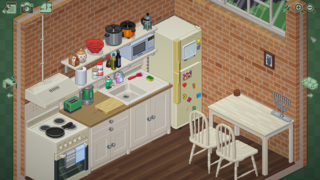
Where you place your stock doesn't just make a statement about your character's aesthetic preferences; how accessible you make each object has a bearing on their lifestyle. To decide whether you put the cookies next to the sink or on top of the cupboards is to decide your sugar intake. The book you leave on your nightstand is one you're probably going to read. However, Unpacking doesn't give us a say in the furniture we set down on the carpet and hardwood. By keeping its household items fixed, the developers can tell their own story about who the protagonist is, whereas Animal Crossing and The Sims assign that task to us.
Unpacking is like a colouring book with furniture; we're shading in a character's life through their belongings. We know they're an artist via their drawing tablet, easel, and markers. We can tell the countries they've travelled to via their souvenirs. Even how cohesive each box of items is tells you something about the character's ability to organise at their current point in life. In their earlier moves, they throw everything into the packs willy-nilly, so you'll find toiletries next to saucepans next to shirts. As they age, they get better at prepping each box for the room it will be dropped into. But what's not obvious from the outset is how many places there are to take Unpacking's central concept or how drastically the activity of unboxing could change with the home we're in.
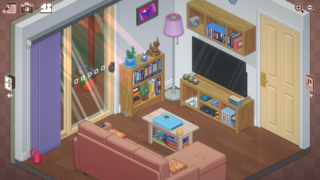
From their family home, the protagonist lands in shared accommodation before cohabiting with a boyfriend in the city. That relationship won't last, and they will retreat to their birth home, but in the following chapters, find a place of their own. Then, a new partner moves in with them, and after, the protagonist will produce a child's picture book. They and their partner will commit to a long-term house, complete with baby room. That doesn't cover every home in the game, but we're hitting the major checkpoints. With each of these life milestones comes a new dimension to the art of organising a home.
When we cohabit for the first time, there are spaces left empty for us to place our toiletries, crockery, and other items. In those gaps, I saw welcoming consideration from roommates. Across the story mode, you experience friendly merges into pairings and other social groups as you place your towels beside other peoples' on the rack or combine your DVD collections. However, there's no shifting anything they've already got settled; that would be rude, so you do this dance of fitting your life around theirs. You must be mindful of them just as they were mindful of you.
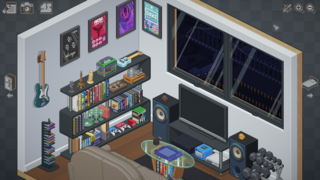
The level in which we set up shop in our boyfriend's home comes with the freedom to pick up and move another person's effects. This mechanic represents our comfort and familiarity with our newfound partner. But despite this person making significant concessions for us in our decorating, there are still plenty of warning signs that the relationship is doomed. As in any failed relationship, those warning signs are more obvious in retrospect. Materials, shape, colour, and purpose differ between the possessions of our feminine protagonist and their masculine counterpart. The protagonist favours furniture that's made from natural materials, is blobby, is colourful, and is decorative, whereas their partner has built a handsome collection of commodities that are synthetic, hard-edged, monochrome, and utilitarian. Whereas the protagonist owns a lot of implements that help them create things, the apartment is full to the brim with instruments, grooming products, and coffee tables, suggesting someone who prefers to acquire things.
You could disagree with the idea that a person's belongings are a mirror of their character or that compatible people can't have different tastes. Yet, the symbolism remains: these two souls don't see eye to eye. Their personalities are worlds apart, and they want different things out of life. In solving this level, we find that there is not space for the artist in the materialist's day-to-day. Even if we can reposition our other half's items to clear space for our own, a copious quantity of appliances and curios means the home is always cramped. They've made more room for themselves than for us, and we always seem to be tip-toeing around their lifestyle.
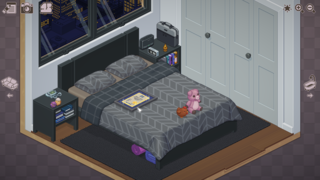
Completing this puzzle requires arduous acts of contortion. I almost went mad trying to find a space for my character's diploma: the symbol of their personal achievements and promise of their career ahead. After a couple of sessions of play, I found that the game let me stamp the level complete if, and only if, I tucked it away under the couple's bed. In this bond, the main character struggles to find a place for their accomplishments and prospects of becoming a professional artist, and must eventually resign themselves to pushing them deep down inside. At the time, it was a relief to just stop fretting.
But this brings us to Unpacking's most obtrusive flaw. This confusion over where we're allowed to situate items extends beyond the purposefully anxiety-inducing apartment stage into the bulk of the game, in which the home is meant to be somewhere to relax and self-express. The rules for placement are too often arbitrary, and the UI won't tell us that we've made a "mistake" until we've hit the bedrock of all our moving boxes. I understand why I can't leave a frisbee in the bathtub or have an egg timer on my bed, but why can't I put my GameBoy in a closet drawer? Or my waste paper bin next to my desk? Even when we move in with our dream spouse, there's a little bit of me that feels like I'm living with a controlling parent.
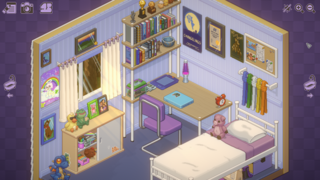
Speaking of which, crawling back to their parent's house with their tail between their legs, the player is likely to feel a sense of failure, but again, we have the benefit of hindsight, and this time, it can put a positive spin on events. In the immediate, returning to the house we grew up in might appear to be a regression to a previous stage of life instead of closing proximity with independence and self-actualisation. However, sometimes you need to move backwards to move forwards. You can't find your dream home until you've moved out of the home you hate. You can't find the right one until you break up with the wrong one. That hope of a future reignites as we place our diploma back on the wall of our bedroom.
Soon, we're opening the door on a house of our own, and this level is a sunny reminder of the freedom and carefree mindset that comes with weaving your own nest. There are no roommates' belongings to worry about, and we aren't so boxed in that we're trying five different arrangements just to get all our crockery into the cupboard. But Unpacking also thinks there's something more rewarding than convenience and legroom. When our character's love moves in with them, they bring what the protagonist's ex didn't. Our lover's belongings are distinct from the main character's through their Japanese cultural bent. However, they do share the same breezy femininity as the main character's. This partner is their own person but one that has a lot in common with the protagonist.
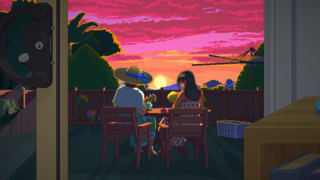
There's a sense of responsibility in making a home for people the protagonist cares about that I don't get in ornamenting a space for myself. This is the chance to establish somewhere a child will remember forever as where they were raised, or our partner might spend the rest of their life. It's a common viewpoint that the home is somewhere we can leave our worries at the door and sink into the sofa, but Unpacking says that the work of building a home where you can feel calm is sometimes stressful. Therefore, our goal can't be to banish domestic frustration entirely; it must be to ensure those frustrations go into making somewhere worth cherishing. Thanks for reading.